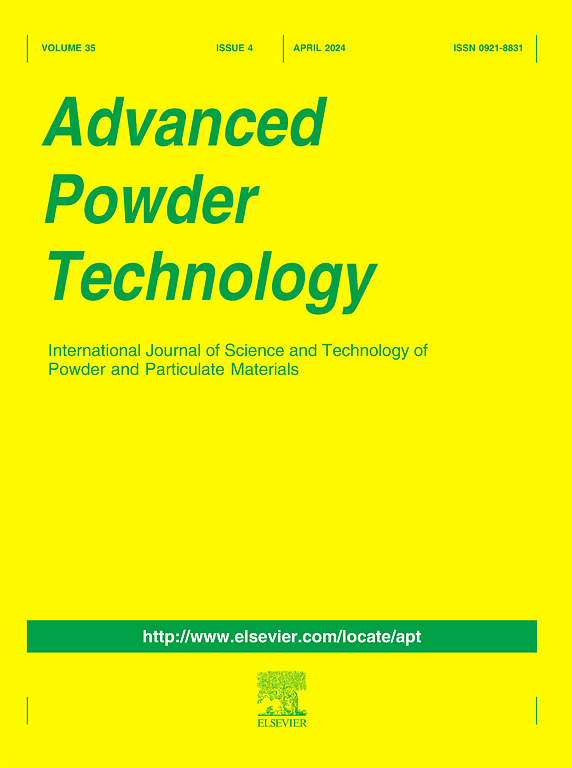颗粒形状引起的剪切波速度快于压缩波速度的现象
IF 4.2
2区 工程技术
Q2 ENGINEERING, CHEMICAL
引用次数: 0
摘要
本研究提供了一系列椭球状聚集体,其中随着形状变得更扁圆,横波传播速度比纵波传播速度快。用离散元法模拟了弹性波的传播,用飞行时间法计算了弹性波的速度。长径比α的增大导致压缩波(P)和剪切波(S)速度的显著降低。α<6,压缩波速大于剪切波速。而当α>;6时,横波速度变快。根据不同椭球体组合的各向异性系数,解释了剪切波速度较快的现象,并计算了等效传播方向。这并不是说形状会产生更大的剪切模量,而是形状的变化会导致弹性波优先沿着特定的接触点传播,在这些接触点上,接触法线的取向相似。这个法向量被称为等效传播方向。随着α的增大,剪切波的等效传播方向与试样的垂直(高度)方向更加一致,而压缩波的方向变化不明显,趋于稳定。越近的方向意味着传播路径越短,速度越快。该研究揭示了由形状引起的独特声学特性,为利用弹性波探测颗粒材料内部结构提供了参考。它还提供了一种构造波可以沿着指定路径传播的材料的想法。本文章由计算机程序翻译,如有差异,请以英文原文为准。

On the phenomenon of shear wave velocity faster than that of compression wave induced by particle shape
This study provides a series of ellipsoidal aggregates in which the shear wave travels faster than the compressional one as the shape becomes more oblate. The propagation of elastic wave is simulated by the discrete element method, and the velocity is calculated by the time-of-flight method. An increase in the aspect ratio α leads to a significant reduction in the velocities of both compression (P) and shear (S) waves. As , the compression wave velocity is bigger than the shear wave velocity. However, when , the shear wave velocity becomes the faster one. According to the anisotropy coefficients of different ellipsoidal assemblies, the phenomenon of a faster shear wave is explained, and the equivalent propagation direction is also calculated. It is not that the shape induces a larger shear modulus, but rather that the variation in shape causes elastic waves to preferentially propagate along specific contact points, where the contact normals are similarly oriented. This normal vector is referred to as the equivalent propagation direction. As increases, the equivalent propagation direction of the shear wave becomes more aligned with the vertical (height) direction of the sample, whereas the direction of the compression wave changes less significantly and tends to stabilize. A closer direction implies a shorter propagation path and a faster velocity. This study demonstrates a distinctive acoustic property induced by shape, which provides references for probing the interior structure of granular material by elastic waves. It also gives an idea to construct material in which wave can propagate along the designated path.
求助全文
通过发布文献求助,成功后即可免费获取论文全文。
去求助
来源期刊

Advanced Powder Technology
工程技术-工程:化工
CiteScore
9.50
自引率
7.70%
发文量
424
审稿时长
55 days
期刊介绍:
The aim of Advanced Powder Technology is to meet the demand for an international journal that integrates all aspects of science and technology research on powder and particulate materials. The journal fulfills this purpose by publishing original research papers, rapid communications, reviews, and translated articles by prominent researchers worldwide.
The editorial work of Advanced Powder Technology, which was founded as the International Journal of the Society of Powder Technology, Japan, is now shared by distinguished board members, who operate in a unique framework designed to respond to the increasing global demand for articles on not only powder and particles, but also on various materials produced from them.
Advanced Powder Technology covers various areas, but a discussion of powder and particles is required in articles. Topics include: Production of powder and particulate materials in gases and liquids(nanoparticles, fine ceramics, pharmaceuticals, novel functional materials, etc.); Aerosol and colloidal processing; Powder and particle characterization; Dynamics and phenomena; Calculation and simulation (CFD, DEM, Monte Carlo method, population balance, etc.); Measurement and control of powder processes; Particle modification; Comminution; Powder handling and operations (storage, transport, granulation, separation, fluidization, etc.)
 求助内容:
求助内容: 应助结果提醒方式:
应助结果提醒方式:


